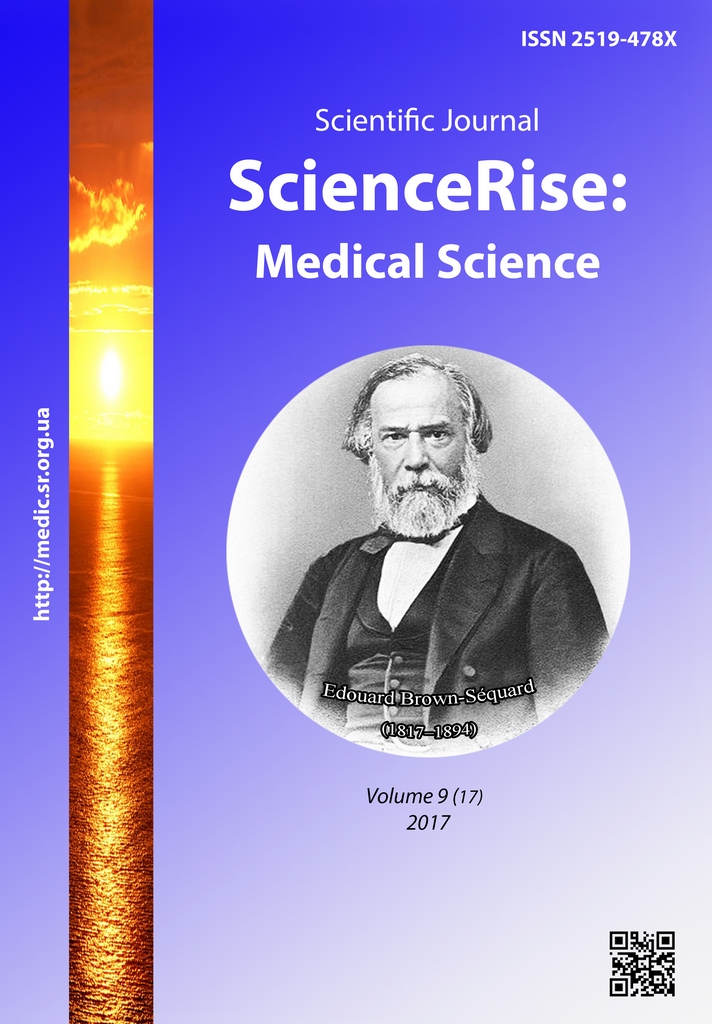Actual approaches to physical rehabilitation of patients with ischemic heart disease and complicated pathology after myocardium surgical revascularization
DOI:
https://doi.org/10.15587/2519-4798.2017.111159Keywords:
ischemic heart disease, surgical revascularization of myocardium, restoration treatment, physical rehabilitationAbstract
The aim of the research is to assess the effectiveness of restoration treatment using hydrokinesotherapy in patients with ischemic heart disease (IHD) and concomitant pathology after surgical revascularization of the myocardium (SRM).
Methods of the research. 280 patients with IHD and concomitant pathology after SRM were examined. 135 patients (group 1)received the standard treatment. 145 patients (group 2) received differentiated complexes of restoration treatment depending on the concomitant pathology adding hydrokinesotherapy. The groups were divided in subgroups depending on the concomitant pathology: А – concomitant arterial hypertension, B – diabetes mellitus, C – osteoarthritis. We realized the dynamic clinical observation of the objective and subjective patients’ states, instrumental and functional methods of examination (ECG, EchoCS, Holter monitoring of ECG, measurement of arterial pressure, heart rate, veloergometry, six-minute test (SMT).
Results. After the course of rehabilitation patients of all groups demonstrated the improvement, but the statistically reliable one was observed in group 2. According to the results of six-minute test of walking (SMT), the increase of the distance by 30,0, 19,6 and 30,0% was observed in subgroup 2А, 2B, 2C corresponding to (p ≤ 0,05). The reliable increase of tolerance to a physical load was observed in patients of 2 group, in subgroup А1- by 80,4, in subgroup 2B - by 62,0, and in subgroup 3B - by 32,2% (p ≤ 0,05).
Conclusions. Thus, the inclusion of hydrokinesotherapy in the complex differentiated programs of rehabilitation of patients with ICD and concomitant pathology after SRM is safe and effective, moreover, it favors the myocardium contractile ability and increase of tolerance to a physical load
References
- Smith, S. C., Benjamin, E. J., Bonow, R. O., Braun, L. T., Creager, M. A., Franklin, B. A. et. al. (2011). AHA/ACCF Secondary Prevention and Risk Reduction Therapy for Patients With Coronary and Other Atherosclerotic Vascular Disease: 2011 Update. Journal of the American College of Cardiology, 58 (23), 2432–2446. doi: 10.1016/j.jacc.2011.10.824
- Kornatsky, V. М. (2013). Regional medical and social problems of circulatory system diseases. Kyiv, 239.
- Smith, S. C., Benjamin, E. J., Bonow, R. O., Braun, L. T., Creager, M. A., Franklin, B. A. et. al. (2011). AHA/ACCF Secondary Prevention and Risk Reduction Therapy for Patients With Coronary and Other Atherosclerotic Vascular Disease: 2011 Update: A Guideline From the American Heart Association and American College of Cardiology Foundation. Circulation, 124 (22), 2458–2473. doi: 10.1161/cir.0b013e318235eb4d
- Boden, W. E., O’Rourke, R. A., Teo, K. K., Hartigan, P. M., Maron, D. J., Kostuk, W. J. et. al. (2007). Optimal Medical Therapy with or without PCI for Stable Coronary Disease. New England Journal of Medicine, 356 (15), 1503–1516. doi: 10.1056/nejmoa070829
- Panagopoulou, E., Montgomery, A., Benos, A. (2006). Quality of life after coronary artery bypass grafting: evaluating the influence of preoperative physical and psychosocial functioning. Journal of Psychosomatic Research, 60 (6), 639–644. doi: 10.1016/j.jpsychores.2005.11.004
- Bradshaw, P. J., Jamrozik, K. D., Gilfillan, I. S., Thompson, P. L. (2006). Asymptomatic long-term survivors of coronary artery bypass surgery enjoy a quality of life equal to the general population. American Heart Journal, 151 (2), 537–544. doi: 10.1016/j.ahj.2005.04.007
- Hammill, B. G., Curtis, L. H., Schulman, K. A., Whellan, D. J. (2009). Relationship Between Cardiac Rehabilitation and Long-Term Risks of Death and Myocardial Infarction Among Elderly Medicare Beneficiaries. Circulation, 121 (1), 63–70. doi: 10.1161/circulationaha.109.876383
- Leon, A. S. (2005). Cardiac Rehabilitation and Secondary Prevention of Coronary Heart Disease: An American Heart Association Scientific Statement From the Council on Clinical Cardiology (Subcommittee on Exercise, Cardiac Rehabilitation, and Prevention) and the Council on Nutrition, Physical Activity, and Metabolism (Subcommittee on Physical Activity), in Collaboration With the American Association of Cardiovascular and Pulmonary Rehabilitation. Circulation, 111 (3), 369–376. doi: 10.1161/01.cir.0000151788.08740.5c
- Bykov, A. T., Malyarenko, T. N., Terent'ev, V. P. (2009). Hydrotherapy: the role of immersion in water and physical exercises in it. Physical education in the prevention, treatment, rehabilitation, 1, 30–43.
- Doroshenko, D. A., Zubarev, A. R., Lapochkina, O. V., Konysheva, O. V., Tyulkina, E. E., Volov, N. A. (2016). Modern methods of intracardiac hemodynamics and cardiac deformability assessment in pregnant women with dilation cardiomyopathy syndrome. Russian Journal of Cardiology, 4, 59–63. doi: 10.15829/1560-4071-2016-4-59-63
- Bokeria, L. A., Aronov, D. M. at. al. (2016). Russian clinical guidelines. Coronary bypass surgery in patients with coronary heart disease: rehabilitation and secondary prevention. CardioSomatics, 7 (3-4), 5–71.
Downloads
Published
How to Cite
Issue
Section
License
Copyright (c) 2017 Olena Kolodenko

This work is licensed under a Creative Commons Attribution 4.0 International License.
Our journal abides by the Creative Commons CC BY copyright rights and permissions for open access journals.
Authors, who are published in this journal, agree to the following conditions:
1. The authors reserve the right to authorship of the work and pass the first publication right of this work to the journal under the terms of a Creative Commons CC BY, which allows others to freely distribute the published research with the obligatory reference to the authors of the original work and the first publication of the work in this journal.
2. The authors have the right to conclude separate supplement agreements that relate to non-exclusive work distribution in the form in which it has been published by the journal (for example, to upload the work to the online storage of the journal or publish it as part of a monograph), provided that the reference to the first publication of the work in this journal is included.









